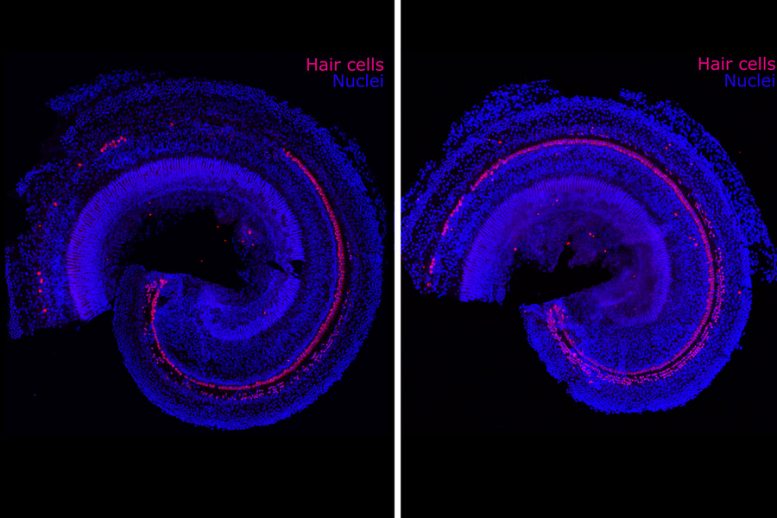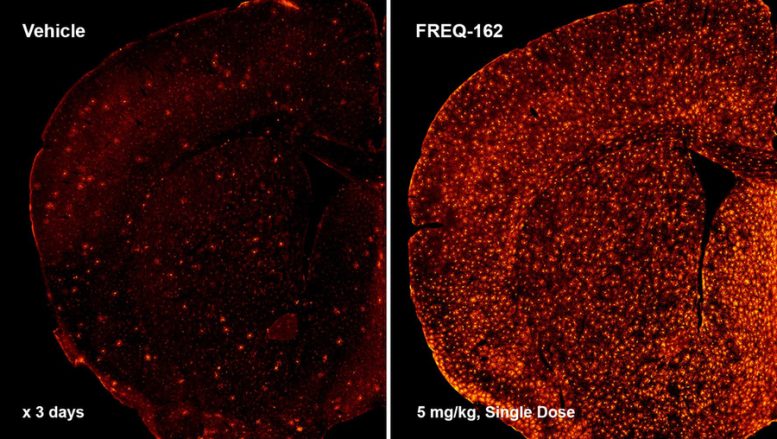
Ces images montrent la régénération cellulaire, en rose, dans un modèle préclinique de perte auditive neurosensorielle. Le témoin est à gauche et le droit a été traité. Crédit : Hinton AS, Yang-Hood A, Schrader AD, Loose C, Ohlemiller KK, McLean WJ.
MIT spinout Frequency Therapeutics’ drug candidate stimulates the growth of hair cells in the inner ear.
The biotechnology company Frequency Therapeutics is seeking to reverse hearing loss — not with hearing aids or implants, but with a new kind of regenerative therapy. The company uses small molecules to program progenitor cells, a descendant of stem cells in the inner ear, to create the tiny hair cells that allow us to hear.
Hair cells die off when exposed to loud noises or drugs including certain chemotherapies and antibiotics. Frequency’s drug candidate is designed to be injected into the ear to regenerate these cells within the cochlea. In clinical trials, the company has already improved people’s hearing as measured by tests of speech perception — the ability to understand speech and recognize words.
“Speech perception is the No. 1 goal for improving hearing and the No. 1 need we hear from patients,” says Frequency co-founder and Chief Scientific Officer Chris Loose PhD ’07.
In Frequency’s first clinical study, the company saw statistically significant improvements in speech perception in some participants after a single injection, with some responses lasting nearly two years.
The company has dosed more than 200 patients to date and has seen clinically meaningful improvements in speech perception in three separate clinical studies. Another study failed to show improvements in hearing compared to the placebo group, but the company attributes that result to flaws in the design of the trial.
Now Frequency is recruiting for a 124-person trial from which preliminary results should be available early next year.

These two images show that one of Frequency’s lead compounds, FREQ-162, drives progenitor cells to turn into oligodendrocytes. The control is on the left and the right has been treated. Credit: Frequency Therapeutics
The company’s founders, including Loose, MIT Institute Professor Robert Langer, CEO David Lucchino MBA ’06, Senior Vice President Will McLean PhD ’14, and Harvard-MIT Health Sciences and Technology affiliate faculty member Jeff Karp, are already gratified to have been able to help people improve their hearing through the trials. They also believe they’re making important contributions toward solving a problem that impacts more than 40 million people in the U.S. and hundreds of millions more around the world.
“Hearing is such an important sense; it connects people to their community and cultivates a sense of identity,” says Karp, who is also a professor of anesthesia at Brigham and Women’s Hospital. “I think the potential to restore hearing will have enormous impact on society.”
From the lab to patients
In 2005, Lucchino was an MBA student in the MIT Sloan School of Management and Loose was a PhD candidate in chemical engineering at MIT. Langer introduced the two aspiring entrepreneurs, and they started working on what would become Semprus BioSciences, a medical device company that won the MIT $100K Entrepreneurship Competition and later sold at a deal valued at up to $80 million.

Frequency Therapeutics co-founders Will McLean, PhD recipient at the Harvard-MIT Division of Health Sciences and Technology (HST), David Lucchino MBA ’06, Jeff Karp, PhD, HST affiliate faculty and Professor at Brigham and Women’s Hospital, and Chris Loose, PhD ’07. Frequency went public on the Nasdaq on October 3, 2019. Credit: Courtesy of Frequency Therapeutics
“MIT has such a wonderful environment of people interested in new ventures that come from different backgrounds, so we’re able to assemble teams of people with diverse skills quickly,” Loose says.
Eight years after playing matchmaker for Lucchino and Loose, Langer began working with Karp to study the lining of the human gut, which regenerates itself almost every day.
With MIT postdoc Xiaolei Yin, who is now a scientific advisor to Frequency, the researchers discovered that the same molecules that control the gut’s stem cells are also used by a close descendant of stem cells called progenitor cells. Like stem cells, progenitor cells can turn into more specialized cells in the body.
“Every time we make an advance, we take a step back and ask how this could be even bigger,” Karp says. “It’s easy to be incremental, but how do we take what we learned and make a massive difference?”
Progenitor cells reside in the inner ear and generate hair cells when humans are in utero, but they become dormant before birth and never again turn into more specialized cells such as the hair cells of the cochlea. Humans are born with about 15,000 hair cells in each cochlea. Such cells die over time and never regenerate.
In 2012, the research team was able to use small molecules to turn progenitor cells into thousands of hair cells in the lab. Karp says no one had ever produced such a large number of hair cells before. He still remembers looking at the results while visiting his family, including his father, who wears a hearing aid.
“I looked at them and said, ‘I think we have a breakthrough,’” Karp says. “That’s the first and only time I’ve used that phrase.”
The advance was enough for Langer to play matchmaker again and bring Loose and Lucchino into the fold to start Frequency Therapeutics.
The founders believe their approach — injecting small molecules into the inner ear to turn progenitor cells into more specialized cells — offers advantages over gene therapies, which may rely on extracting a patient’s cells, programming them in a lab, and then delivering them to the right area.
“Tissues throughout your body contain progenitor cells, so we see a huge range of applications,” Loose says. “We believe this is the future of regenerative medicine.”
Advancing regenerative medicine
Frequency’s founders have been thrilled to watch their lab work mature into an impactful drug candidate in clinical trials.
“Some of these people [in the trials] ne pouvaient pas entendre pendant 30 ans, et pour la première fois ils ont dit qu’ils pouvaient aller dans un restaurant bondé et entendre ce que leurs enfants disaient”, dit Langer. “C’est tellement significatif pour eux. Il est évident qu’il faut faire plus, mais le simple fait de pouvoir aider un petit groupe de personnes est vraiment impressionnant pour moi.”
Karp pense que le travail de Frequency fera progresser la capacité des chercheurs à manipuler les cellules progénitrices et conduira à de nouveaux traitements à terme.
“Je ne serais pas surpris si, dans 10 ou 15 ans, en raison des ressources investies dans ce domaine et de l’incroyable travail scientifique réalisé, nous arrivions à un point où… [reversing hearing loss] serait similaire à la chirurgie Lasik, où vous êtes entré et sorti en une heure ou deux et vous pouvez complètement restaurer votre vision”, dit Karp. “Je pense que nous verrons la même chose pour la perte d’audition”.
La société développe également un médicament pour la sclérose en plaques (SEP), une maladie dans laquelle le système immunitaire attaque la myéline dans le cerveau et le système nerveux central. Les cellules progénitrices se transforment déjà en cellules productrices de myéline dans le cerveau, mais pas assez rapidement pour compenser les pertes subies par les patients atteints de SEP. La plupart des traitements de la SEP se concentrent sur la suppression du système immunitaire plutôt que sur la production de myéline.
Les premières versions de ce médicament candidat ont montré une augmentation spectaculaire de la myéline dans les études sur les souris. La société prévoit de déposer une demande de nouveau médicament de recherche pour la SEP auprès de la FDA l’année prochaine.
“Lorsque nous avons conçu ce projet, nous voulions qu’il s’agisse d’une plateforme pouvant être appliquée à de nombreux tissus. Maintenant, nous passons au travail sur la remyélinisation, et pour moi, c’est la partie émergée de l’iceberg en termes de ce qui peut être fait en prenant de petites molécules et en contrôlant la biologie locale”, dit Karp.
Pour l’instant, M. Karp est déjà enthousiasmé par les progrès de Frequency, qui ont fait mouche la dernière fois qu’il s’est rendu dans les bureaux de Frequency et qu’il a rencontré une conférencière qui lui a fait part de son expérience de la perte d’audition.
“Vous espérez toujours que votre travail aura un impact, mais cela peut prendre beaucoup de temps pour que cela se produise”, dit Karp. “Cela a été une expérience incroyable de travailler avec l’équipe pour faire avancer ce projet. Il y a déjà des personnes dans les essais dont l’audition a été améliorée de façon spectaculaire et leur vie a été changée. Cela a un impact sur les interactions avec la famille et les amis. C’est merveilleux d’en faire partie”.



